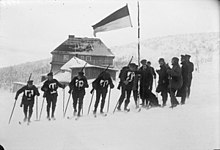Talk:Cross-country skiing/sandbox
 | |
| Highest governing body | FIS |
|---|---|
| Characteristics | |
| Contact | No |
| Mixed-sex | No |
| Type | Winter sport |
| Equipment | Skis, poles, boots, bindings |
| Presence | |
| Olympic | 1924 |
| Paralympic | 1976 |
Cross-country ski competition encompasses a variety of formats for cross-country skiing races over courses of varying lengths according to rules sanctioned by the International Ski Federation and by national organizations, such as the U.S. Ski and Snowboard Association and Cross Country Ski Canada/Ski de Fond Canada. International competitions include the FIS Nordic World Ski Championships, the FIS Cross-Country World Cup, and at the Winter Olympic Games. Such races occur over homologated, groomed courses designed to support classic (in-track) and free-style events, where the skiers may employ skate skiing. It also encompasses cross-country ski marathon events, sanctioned by the Worldloppet Ski Federation, and cross-country ski orienteering events, sanctioned by the International Orienteering Federation.
History
[edit]
Norwegian army units were skiing for sport (and prizes) in the 18th century. Olympic timeline:[1]  The FIS Nordic World Ski Championships have been held in various numbers and types of events since 1925 for men and since 1954 for women. From 1924 to 1939, the World Championships were held every year, including the Winter Olympics. After World War II, the World Championships were held every four years from 1950 to 1982. Since 1985, the World Championships have been held in odd-numbered years.[2]
- 1924 Winter Olympics: Cross-country skiing debuts.
- 1952 Winter Olympics.: Women’s Nordic skiing debuts
- 1956 Winter Olympics: men’s 30km and the women’s 3x5km added.
- 1964 Winter Olympics: Women’s 5km added.
- Paralympic cross-country skiing debuts at the 1976 Winter Paralympics.
- 1980: Women’s 20km added.
- 1989: Men’s 15km and women’s 10km replaced with the pursuit.
- 2002 Winter Olympics: Appearance of sprint and mass start events in Salt Lake City.
Competition has been evolving to make it more interesting for spectators.

The Winter Olympics, the FIS Nordic World Ski Championships, and the FIS World Cup events (including the Holmenkollen and the Tour de Ski, a grueling nine race series completed in eleven days) have long been a showcase for the world's fastest cross country skiers. There are also special distance ski races, sometimes called ski marathons, like Vasaloppet in Sweden, Birkebeineren in Norway, the Engadin Skimarathon in Switzerland, the American Birkebeiner, and the Tour of Anchorage in Anchorage, Alaska.
Competition
[edit]
Competitive cross-country skiing is sanctioned through the International Ski Federation (FIS). Notable cross-country ski competitions include the Winter Olympics, the FIS Nordic World Ski Championships, and the FIS World Cup events (including the Holmenkollen. Notable ski marathons, include the Vasaloppet in Sweden, Birkebeineren in Norway, the Engadin Skimarathon in Switzerland, the American Birkebeiner, the Tour of Anchorage in Anchorage, Alaska, and the Boreal Loppet, held in Forestville, Quebec, Canada.[3]
Ski orienteering is a form of cross-country skiing competition that requires navigation in a landscape, making optimal route choices at racing speeds. Standard orienteering maps are used, but with special green overprinting of trails and tracks to indicate their navigability in snow; other symbols indicate whether any roads are snow-covered or clear. Standard skate-skiing equipment is used, along with a map holder attached to the chest. It is one of the four orienteering disciplines recognized by the International Orienteering Federation. Upper body strength is especially important because of frequent double poling along narrow snow trails.[4]
Technique
[edit]In classic cross-country skiing the skis remain parallel and pointed straight ahead. The poles are planted alternately on the opposite side to the kick. The underside of the skis has a sticky section in the middle created either with ski wax or with scales.[5] When descending a hill, the telemark or the snowplough turn is used.
Skate-skiing is a newer, faster, techniquec. The skis mostly remain in a V-shape. There is no grip section under the ski, since the kick is provided by the skis' inside edges. Skis are waxed with a glide wax over their entire length, making them faster than classic skis. Skate skiing can only be done on smooth and wide specially-groomed trails.[5]
Equipment
[edit]- Skis used in cross-country are lighter and narrower than those used in alpine skiing and have long curved tips. For classic events, the minimum length is 195 to 210 centimetres, while the average length for skating 170-200cm.[1] Skis are waxed for speed and control.
- Ski poles are used for balance and propulsion.
- Ski boots are attached to the bindings only at the toe, leaving the heel free.
References
[edit]- ^ a b "Cross Country Skiing Equipment and History". International Olympic Committee. Retrieved 11 October 2014.
- ^
Editors. "FIS History". About FIS. International Ski Federation. Retrieved 2014-10-23.
{{cite web}}:|last=has generic name (help) - ^
Editors (2012). "What is Worldloppet?". Worldloppet Ski Federation. Retrieved 2014-10-23.
{{cite web}}:|last=has generic name (help) - ^ "Ski Orienteering". The Canadian Orienteering Federation. Retrieved 2008-05-26.
- ^ a b "Adult Cross-Country Skiing Instruction". Weston Ski Track. Retrieved 18 October 2014.

